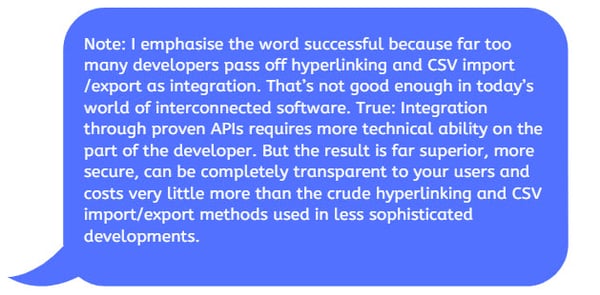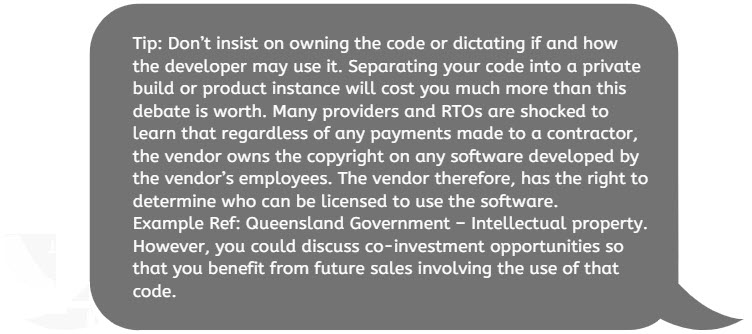
We work with RTOs in all shapes and sizes and I can honestly say, the most difficult providers to cater for are CRICOS / ELICOS providers. I’m not suggesting for a minute that the providers themselves are difficult or hard to please. On the contrary, almost every provider we’ve met is professional, friendly and approachable. They are trying their hardest to comply and do the right thing.
The real problem they and we, as their system providers face is the “four-edge-sword” of compliance. Compliance makes it difficult for them and their software vendors like us to come up with cost-effective solutions. I’ve yet to find a single CRICOS / ELICOS provider that is totally satisfied with their student management system. In most cases they put up with it grudgingly, because they know the alternatives are little or no better. And who wants to jump out of a tolerable frying pan into a potentially raging fire.
What is the four-edge-sword of compliance?
Before a CRICOS / ELICOS provider can even think about running a profitable business they have to comply with the National Code of Practice of Education and Training to Overseas Students 2018.
There’s no argument. All these requirements are perfectly legitimate and reasonable, given the Australian Governments obligations to protect students, Australian citizens and visitors to our country. But by some unfortunate twist of fate, they’ve all come together in the provider’s lap. Now on top of the elusive goal of trying to run a profitable business, these providers also must:
- Report breaches of Visa conditions,
- Ensure the highest standards of transparency, fairness and support for students,
- Submit accurate AVETMISS reports,
- Ensure students have verified USIs, and
- Confirm they have adequate English Language skills to undertake the training.
Any reasonable business person would conclude: “I need a system!”

In search of the Holy Grail
Here’s the scenario. Mario’s college is in the business of training international students who want to work in the hospitality industry. Mario is passionate about the industry and has built a very successful teaching business offering qualifications in hospitality. Now he wants to offer his courses to International Students. Mario, an astute businessman took one look at compliance reporting requirements and decided “surely, there are systems and consultants out there that can help me manage all of this!”
Consultants, no problem. Mario was able to find an excellent consultant quite quickly. She was able to advise him of his legal obligations, guide him through the National Code and provide practical tips and best-practice procedures for managing the college. What was not so straight forward was finding a suitable system.
Mario googled day and night, consulted with friends, advisors and people in the same position. In the end he concluded that: no one he spoke to was satisfied with any of the advertised systems, none of them tick all the boxes, the few demos he looked at showed outdated and complicated software, and most of the vendors seemed to have no clue what a CRICOS provider does or needs. Mario decides the best course of action is to implement whatever his consultant recommends. But of course, she can only recommend whatever’s out there. Unsurprisingly, this leads to Mario having to choose the best of a bad bunch.
Why are there no good systems for CRICOS providers?
All good software starts with motivation. Software vendors need to run profitable businesses, just like everyone else. The most likely vendors to provide a CRICOS solution are the 30 or so suppliers of AVETMISS-compliant student management systems. At least they tick the RTO reporting box in table 1. So now we’re going to ask this handful of small software development businesses to take on the daunting task of developing a highly specialised solution that is at least as complex as the entire AVETMISS-compliant system that they just spent the last 8 to 10 years building.
What’s their motivation? There are just over 4,000 RTOs who are currently active in Australia, CRICOS providers are a subset of that small market, totaling about 1,400. Many of those are universities, schools and colleges that have their own proprietary systems and are effectively excluded from the market. Amortizing the cost of software development across the RTO market by itself presents a challenging business case. Developing a technical solution that is arguably more complex for a quarter of that small market is very difficult for a small software business to justify.
Considering that a good AVETMISS-compliant student management system is not too many steps away from a fully-fledged LMS; compare the RTO/CRICOS market to the worldwide market for Learning Management Systems. These are published LMS market facts and predictions.

Figure 1 - Ref www.researchandmarkets.com
Note: CAGAR = Compound Annual Growth Rate
Sure, there are many more competitors in that space and growing by the day. But as a software vendor you’d have to question the justification for investing significant R&D in the CRICOS systems market when this sort of potential is out there.
So, what’s the solution?
For those who say, “There must be better systems available for CRICOS providers”. You’re right, there should be. But hopefully the above explains why there aren’t.
To create the solution, we would have to work as a team: consultant, provider and vendor. Let’s assume there is no off-the-shelf-solution that ticks all the boxes, not even the important ones. The next best solution is one that is configurable, but configurability assumes the developers have already thought about the options. Trust me, if they had they would have implemented them. That leaves customisation or manual handling as your only choices:
- Hybrid manual and automated system. Determine what is easy and practical to do manually and use available automation if and where it exists.
- Full automation through customisation delivered over several stages.
- Do both, making (1) the first of a series of planned stages.
Then there’s the cost. A very average software change or addition can cost well over $10,000 in development, test, project management, documentation and deployment. And it must be maintained.
If you’re going to invest that sort of money in a system you need to make sure you’re getting value for money. Here are some strategies to help you get the best ROI:
- Adopt a staged, AGILE development approach so that you get an ROI at each stage. It starts with scoping - clearly specified requirements and project milestones. A good dev team will assist with this.
- Accept that you’ll probably need to do some processes manually at the start. But you can’t build everything overnight, even if you had the budget to do so. Doing things manually at the start teaches everyone how to automate better, leading to better specifications and a better solution.
- Choose a system and a development team that has the right blueprint for success. They must understand the ESOS standards and the needs of an RTO and a CRICOS / ELICOS provider. They must be highly experienced in the AGILE development methodology and developing the kinds of solutions you need. AGILE enables you to get immediate benefits at the end of each stage.
- Integrate where possible to minimise the cost of re-inventing wheels that already exist. Calendars, Email, Document Management, Scheduling tools, and many of processes tools you’ll need are available from companies like Microsoft, Google and others. They have published application program interfaces (APIs), enabling you to integrate the functionality into your solution. Even if these solutions are not optimal in the long term, integration will give you quick, cost-effective, automated solutions in the short term. Most providers don’t look back once a successful integration project has been implemented.

- Insist on a User Acceptance Test (UAT) phase, with documentation and appropriate support before you sign off on any stage. It’s normal to pay an agreed sum on delivery but retain final payment until you have internally tested and accepted the work and the documentation.
- Ensure that there is a clear maintenance process in place, so that your custom features will be maintained and tested on all future releases of the software.

- Documentation, training and support should be included in the scope of work to ensure that (a) your evaluation team is able to effectively perform user acceptance testing and (b) you have all the tools and support you need to maximise your ROI after GoLive
Queensland Government – Intellectual property.
In Conclusion
Hopefully, this explains why there are no outstanding CRICOS systems available to you. The solution I’ve presented is by no means a silver bullet. It’s an honest opinion. But it could help you get exactly what you need with minimal financial risk or time-wasted on dead-end trials. Identifying what you need to efficiently plan and develop a CRICOS system for your business can be challenging. With over 20 years of industry experience, and a long list of active training providers, we are happy to share our experience and help you succeed.
We have also partnered with RTO Doctor to give away a copy of their latest book. Packed with expert advice, examples and tips, Top 5 Compliance Tips To Rescue Your RTO is a crucial read for all providers around the country, CRICOS or not! With a special section devoted to a current focus by regulators on breaches of Section 8 of the ESOS Act 2000 also, associated discounts and promos, you can’t afford to not read this book!
